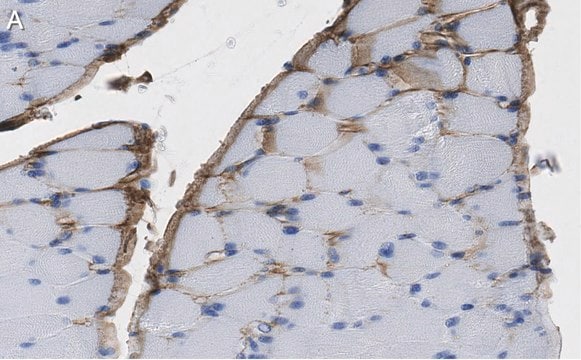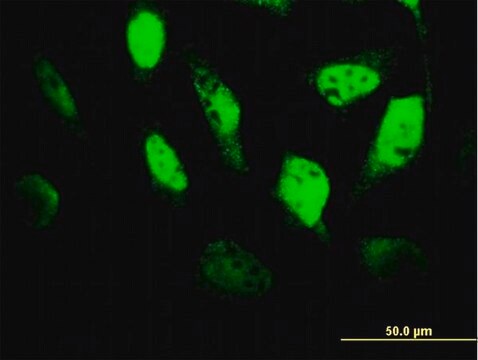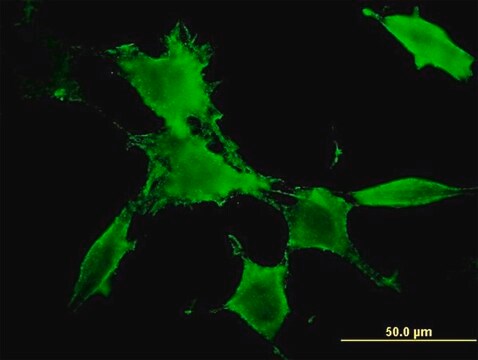推荐产品
生物源
rat
品質等級
共軛
unconjugated
抗體表格
purified antibody
抗體產品種類
primary antibodies
無性繁殖
ER-TR7, monoclonal
純化經由
using protein G
物種活性
mouse, human
包裝
antibody small pack of 100 μg
技術
immunofluorescence: suitable
immunohistochemistry (formalin-fixed, paraffin-embedded sections): suitable
同型
IgG2a
表位序列
Unknown
UniProt登錄號
運輸包裝
2-8°C
目標翻譯後修改
unmodified
一般說明
Connective tissue is responsible for maintaining the form of the body and its organs and provides cohesion and internal support. It includes several types of fibrous tissue that vary only in their density and cellularity. The cells of connective tissue include fibroblasts and adipose cells that are relatively stationary and several types of motile migrating cells, such as mast cells, macrophages, monocytes, lymphocytes, plasma cells, and eosinophils. These cells of connective tissue develop during embryonic life from the mesenchyme. Fibroblasts are the least specialized cells in the connective-tissue family. They are dispersed in connective tissue throughout the body, where they secrete a nonrigid extracellular matrix that is rich in type I and/or type III collagen. In skin fibroblasts originate from two distinct lineage of cells: one lineage populates the papillary dermis, and the other lineage populates the reticular dermis, that have distinct cell markers and distinct functional abilities. Clone ER-TR specifically detects an antigen present in, and produced by, reticular fibroblasts. This clone is useful to stain the microanatomy of various organs, in particular the connective tissue framework in lymphoid organs. It is also shown to detect reticular fibroblasts in thymus. (Ref.: Van Vliet, E., et al. (1984). Eur. J. Immunol. 14(6); 524-529).
特異性
Clone ER-TR7 is a rat monoclonal antibody that detects Reticular fibroblasts.
免疫原
Thymic stromal cells isolated from C3H mice.
應用
Quality Control Testing
Evaluated by Immunohistochemistry in Mouse thymus tissue sections.
Immunohistochemistry Applications: A 1:50 dilution of this antibody detected reticular fibroblasts in frozen section of Mouse thymus tissue.
Tested applications
Immunofluorescence Analysis: A representative lot detected Reticular fibroblasts clone ER-TR7 in Immunofluorescence applications (Van Vliet, E., et al. (1984). Eur J Immunol. 14(6):524-9; Nolte, M.A., et al. (2003). J Exp Med. 198(3):505-12; Sixt, M., et al. (2005). Immunity. 22(1):19-29; Link, A., et al. (2007). Nat Immunol. 8(11):1255-65; Odaka, C., et al. (2009). J Histochem Cytochem. 57(4):373-82; Schiavinato, A., et al. (2021). Eur J Immunol. 51(9):2345-2347).
Immunohistochemistry Applications: A representative lot detected Reticular fibroblasts clone ER-TR7 in Immunohistochemistry applications (Van Vliet, E., et al. (1984). Eur J Immunol. 14(6):524-9; Nolte, M.A., et al. (2003). J Exp Med. 198(3):505-12; Sixt, M., et al. (2005). Immunity. 22(1):19-29; Link, A., et al. (2007). Nat Immunol.;8(11):1255-65; Odaka, C., et al. (2009). J Histochem Cytochem. 57(4):373-82; Schiavinato, A., et al. (2021). Eur J Immunol. 51(9):2345-2347).
Note: Actual optimal working dilutions must be determined by end user as specimens, and experimental conditions may vary with the end user
Evaluated by Immunohistochemistry in Mouse thymus tissue sections.
Immunohistochemistry Applications: A 1:50 dilution of this antibody detected reticular fibroblasts in frozen section of Mouse thymus tissue.
Tested applications
Immunofluorescence Analysis: A representative lot detected Reticular fibroblasts clone ER-TR7 in Immunofluorescence applications (Van Vliet, E., et al. (1984). Eur J Immunol. 14(6):524-9; Nolte, M.A., et al. (2003). J Exp Med. 198(3):505-12; Sixt, M., et al. (2005). Immunity. 22(1):19-29; Link, A., et al. (2007). Nat Immunol. 8(11):1255-65; Odaka, C., et al. (2009). J Histochem Cytochem. 57(4):373-82; Schiavinato, A., et al. (2021). Eur J Immunol. 51(9):2345-2347).
Immunohistochemistry Applications: A representative lot detected Reticular fibroblasts clone ER-TR7 in Immunohistochemistry applications (Van Vliet, E., et al. (1984). Eur J Immunol. 14(6):524-9; Nolte, M.A., et al. (2003). J Exp Med. 198(3):505-12; Sixt, M., et al. (2005). Immunity. 22(1):19-29; Link, A., et al. (2007). Nat Immunol.;8(11):1255-65; Odaka, C., et al. (2009). J Histochem Cytochem. 57(4):373-82; Schiavinato, A., et al. (2021). Eur J Immunol. 51(9):2345-2347).
Note: Actual optimal working dilutions must be determined by end user as specimens, and experimental conditions may vary with the end user
Anti-Reticular fibroblasts, clone ER-TR7, Cat. No. MABF2804, is a rat monoclonal antibody that detects Reticular fibroblasts and is tested for use in Immunofluorescence and Immunohistochemistry.
外觀
Purified rat monoclonal antibody IgG2a in buffer containing 0.1 M Tris-Glycine (pH 7.4), 150 mM NaCl with 0.05% sodium azide.
儲存和穩定性
Recommended storage: +2°C to +8°C.
其他說明
Concentration: Please refer to the Certificate of Analysis for the lot-specific concentration.
免責聲明
Unless otherwise stated in our catalog or other company documentation accompanying the product(s), our products are intended for research use only and are not to be used for any other purpose, which includes but is not limited to, unauthorized commercial uses, in vitro diagnostic uses, ex vivo or in vivo therapeutic uses or any type of consumption or application to humans or animals.
未找到合适的产品?
试试我们的产品选型工具.
儲存類別代碼
12 - Non Combustible Liquids
水污染物質分類(WGK)
WGK 1
閃點(°F)
Not applicable
閃點(°C)
Not applicable
我们的科学家团队拥有各种研究领域经验,包括生命科学、材料科学、化学合成、色谱、分析及许多其他领域.
联系技术服务部门








